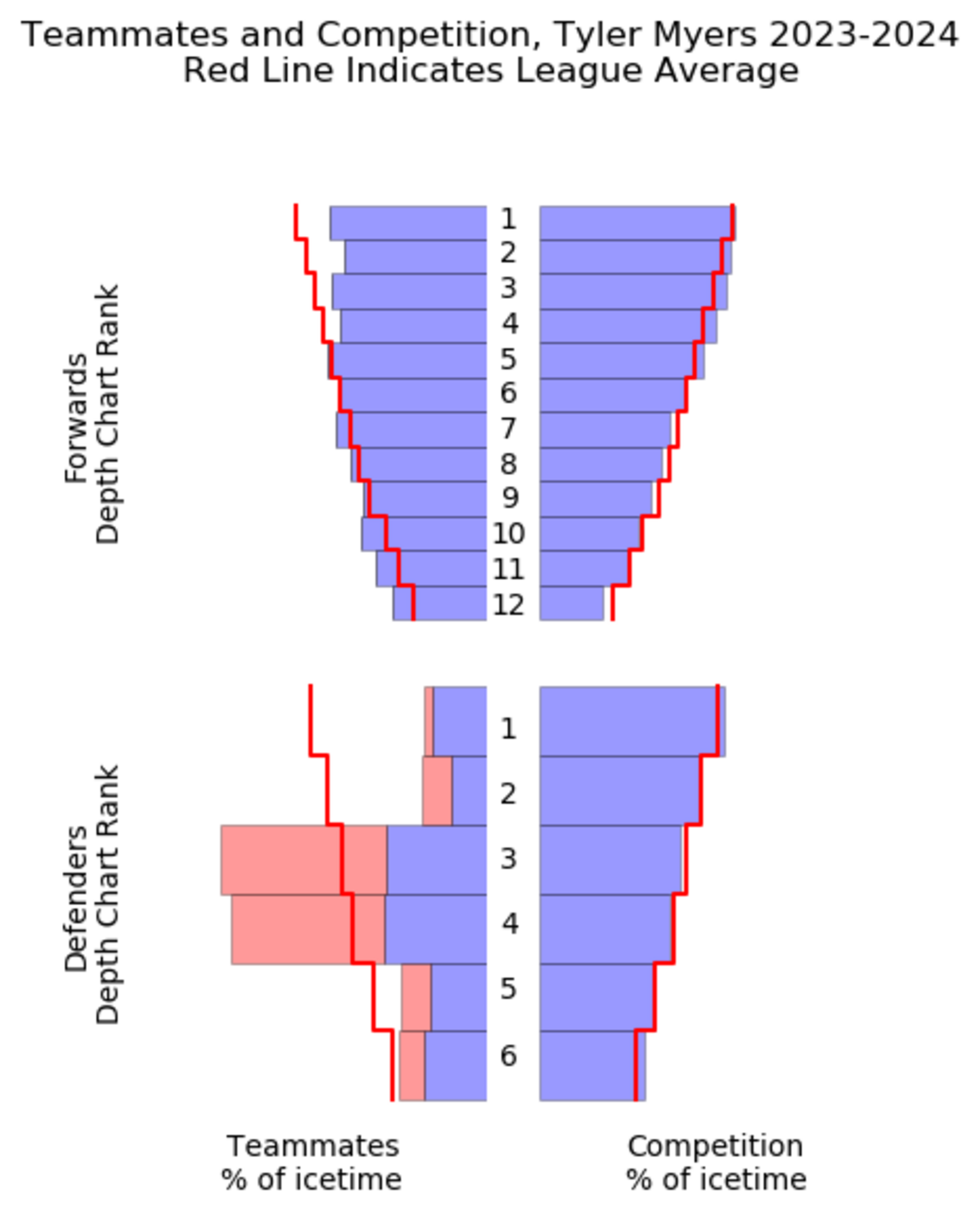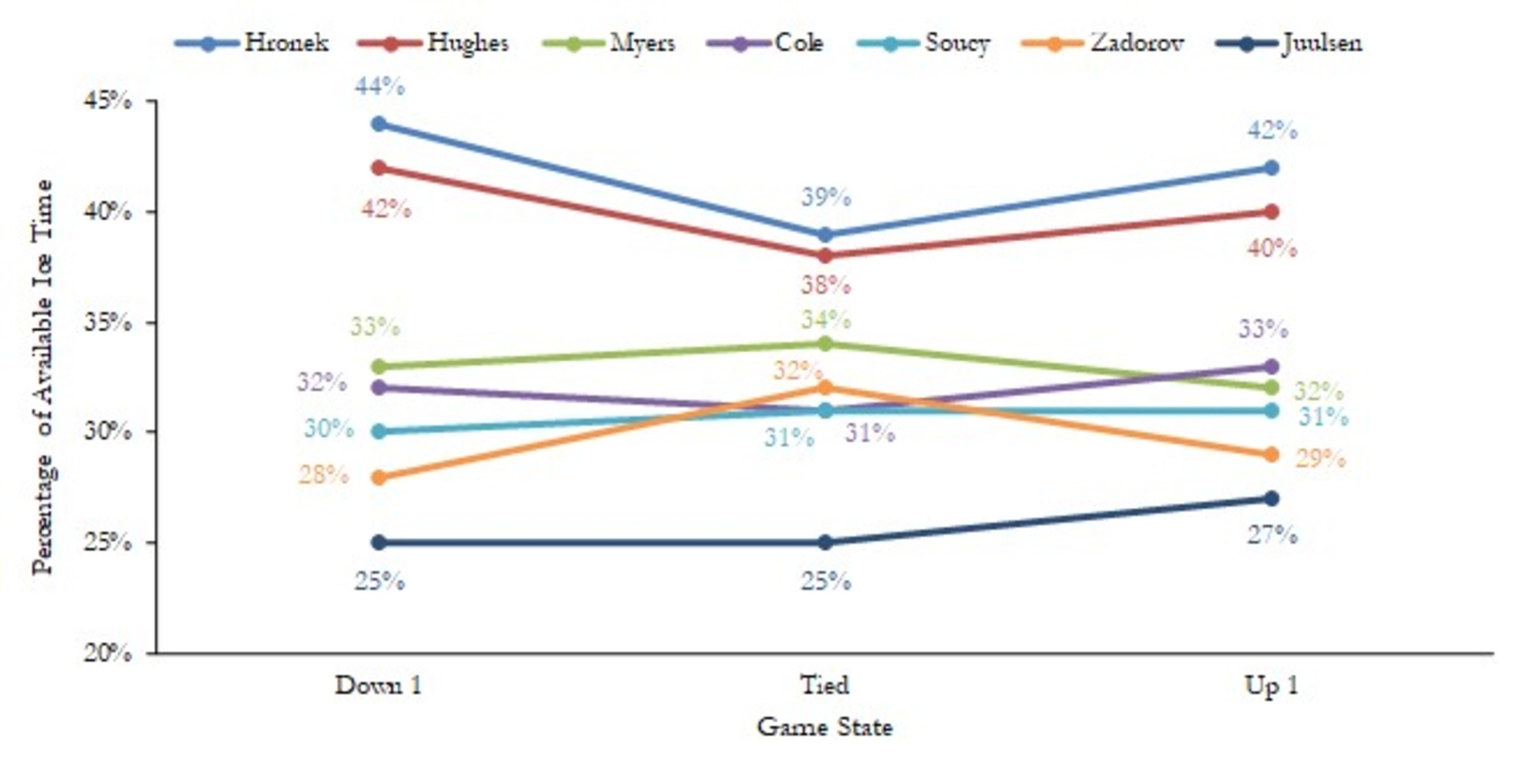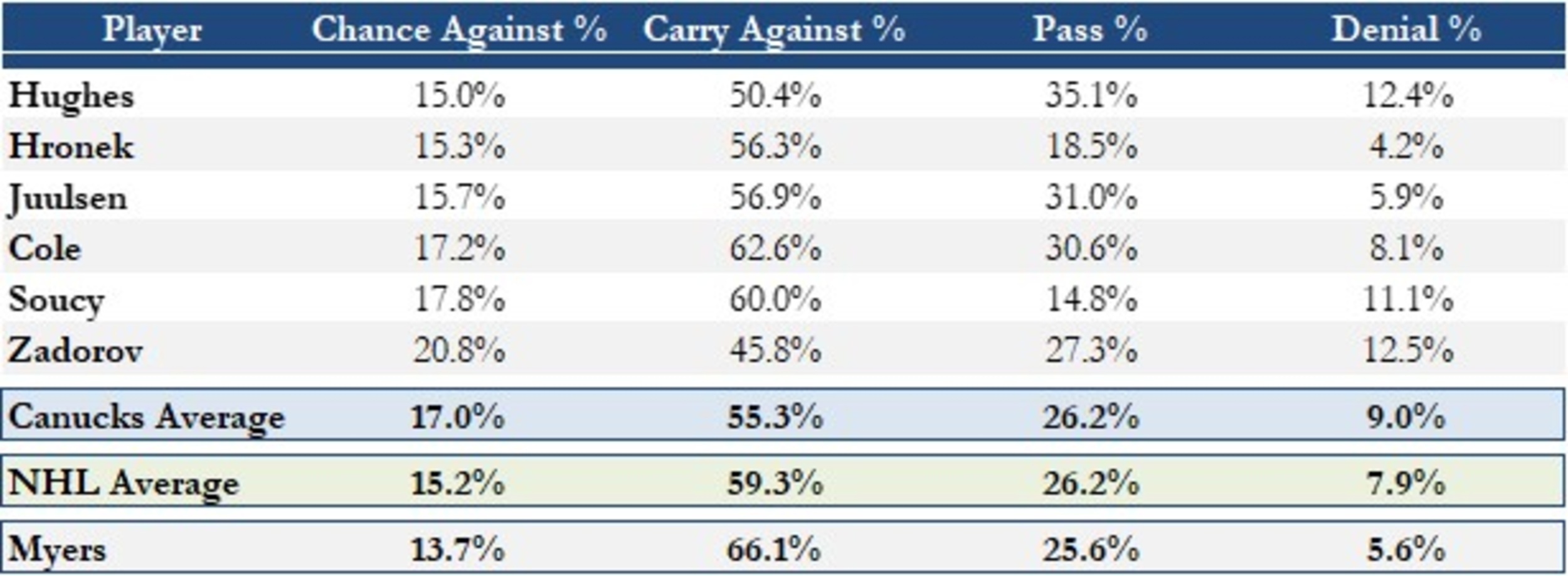
Tyler Myers’ polarizing stint in Vancouver began the second Jim Benning signed him to a 5-year, $30-million-dollar contract on day one of NHL Free Agency on July 1st, 2019.
Myers immediately struggled under the weight of the club’s thinly staffed blueline. His lofty UFA contract valuation and the team’s inconsistent play made Myers a shining example of the Benning era’s consistent inability to allocate cap space meaningfully toward constructing a competitive, modern NHL backend.
There was plenty of off-season discourse in this market that, should the Canucks disappoint in the 2023-2024 season, Myers could be one of the pieces moved at the trade deadline, especially given his expiring contract status.
Then the Canucks started winning.
For the first time in his Canucks tenure, the spotlight was no longer shining on everything that Myers wasn’t bringing to the table as a $6-million-dollar per-year defenceman. Instead, the final year of Myers’ contract has seen the 6’8″ right-shot defenceman provide on-ice value commensurate with his heft price tag.
Myers is currently sidelined week-to-week with a lower-body injury he suffered against the LA Kings. We thought it would be prudent to take a step back and evaluate the towering defenceman’s season thus far. The objective of this article isn’t to claim that Myers has contributed in excess of the value of his contract. Instead, it’s to recognize that after years of being Vancouver’s top right-shot option on an extremely limited defence corps, the Canucks hockey operations have constructed a roster this season in which Myers’ can be deployed in a second-pairing role best suited for his skill set and true talent ability—and it’s one in which he has been mostly effective.
The Boxscore
After posting a career-high 48 points in his rookie season with the Buffalo Sabres, Myers has been consistently able to chip in at around a 30-point pace, with most of that production coming at even strength. Myers’ counting stats dipped when he joined the Canucks’ line-up, but he’s rebounded back into that production form this season while playing behind the Hughes-Hronek pair.
Myers has provided credible secondary scoring from the blueline this season and is up to 23 points on the year, good for third on the Canucks. It’s an important mark to note, considering the next highest-scoring defencemen on the roster are Nikita Zadorov and Ian Cole, who have each contributed 2 goals and 6 assists.
At 5-on-5, the gulf in offensive production on a points-per-60 basis between the Hughes-Hronek pair and every other Canucks defender is massive, but the gap between Myers and the rest of the defence corp is wide as well. In this context, Myers has played a key role in driving offence from the blueline when Vancouver’s top duo takes a breather.

Two key developments this season have helped Myers settle into a more consistent second-pairing role. First, the emergence of the Hughes-Hronek pair as an elite play-driving duo capable of being deployed in critical moments and match-up minutes. Second, the club’s infinitely more reliable third pairing that the coaching staff has been able to roll out without bleeding chances against.
These new luxuries have afforded the Canucks’ coaching staff greater control over the consistency of Myers’ deployment, and this has allowed him to settle nicely into a quality second-pairing role.
Deployment and Shot Shares
Myers has shared the ice with Ian Cole, Carson Soucy, and Nikita Zadorov as his most common defence partners, having spent over 200+ minutes with each player at 5-on-5. Regardless of his partner, Myers has been tasked with matching up against better-than-average competition without sharing the ice as frequently with Vancouver’s top forwards, as shown below:

Via HockeyViz
In these minutes, Myers has posted his most reliable two-way results with Cole. While both Cole and Soucy seem to benefit from playing with Myers vs. without, it’s worth noting that the Canucks have been out-muscled in shot metric terms when Myers has hit the ice with Soucy and Zadorov. Interestingly, Zadorov has fared better without Myers, given how his most frequent partner away from him is Noah Juulsen. Granted, those minutes have been somewhat sheltered and have typically come against weaker opposition.

Beyond counting stats, it’s also helpful to understand how Myers has been deployed under Rick Tocchet and his coaching team. One way to measure the coaching staff’s trust in Myers is to understand his deployment in high-leverage, relatively-even game states (defined here as plus or minus one goal differential). Within these instances, Myers is the third most frequently used defender after Hughes and Hronek:

Via HockeyViz
Transitional Play
One of the key tenets of Rick Tocchet’s 5-on-5 playstyle is fast transitional play. The team focuses heavily on quick-ups from the defence to the forwards, at which point the team attempts to gain entry into the offensive zone. Myers’ decision-making when it comes to zone exits has been heavily scrutinized in this market, but his ability to transport the puck out of the defensive zone has been effective this season, both compared against his Canucks peers and as well as his peers across the league:

What’s interesting to note in this dataset is that the Canucks, on average, exit the defensive zone at a more proficient clip relative to league-average but do so with possession less often. This may be a reflection of Tocchet’s quick-up philosophy, which at times may include chipping pucks off the wall or deflection exits into the neutral zone for the forwards to chase onto.
Historically, Myers has been much maligned for his poor decision-making and costly turnovers on the breakout. Generally, however, Myers has been able to eliminate those types of plays from his game. Here’s a simple example from early in the first period in the Canucks’ recent home match-up against the Penguins.
Myers receives a pass from Cole and immediately looks for a quick-up option. However, recognizing a Penguins forechecker immediately cutting off the middle lane and a second Pittsburg player cutting off a banked pass along the wall, Myers holds onto the puck for an extra half-second before returning a pass to Cole, who now has an open field of play in front of him. It’s a simple play, but Myers has been guilty of making these types of defensive gaffes before.
However, his hockey hasn’t been totally mistake-free. Here’s an example from the same game against the Penguins, this time beginning with a defensive zone draw.
Sam Lafferty—flanked by Blueger and Di Guiseppe—wins a faceoff cleanly from the right circle. Recognizing the clean win, the wingers follow a set play and bee-line out of the zone, with Blueger sticking close to the wall and Di Giuseppe going up the middle to give Myers a secondary option.
As the play develops, Evgeni Malkin recognizes Blueger’s route and goes to cut off any pass attempt up the boards. However, Myers fails to recognize that he now has two layers to play through, as both Drew O’Connor and Malkin are now well-positioned to take away that rimmed pass. Malkin ends up intercepting the banked attempt and passes laterally to Valtteri Puustinen, who—luckily for Vancouver—misses the pass. Ideally, Myers can recognize the coverage and either reset behind his net or high-flip to neutral ice, where both Blueger and Di Giuseppe can skate onto and fight for a loose puck.
On the defensive end, Myers’ success defending in transition against opponent zone entries has been mixed. Myers is vulnerable to controlled carries and pass-based entries and has the lowest denial success rate out of Vancouver’s regular defenders. However, once opponents enter the Canucks’ end, Myers’ reach and skating allow him to suppress chances at a team-best clip—this suggests that while he’s passive in defending the blueline, his in-zone defending ability makes it difficult for opposing forwards to create anything meaningful once they gain the offensive zone:

Hughes’ skating ability is clearly a separating factor that allows him to deny opposing zone entry attempts. At the same time, Soucy and Zadorov are big-bodied, sturdy skating defencemen who aren’t shy to use their physical attributes and sheer reach to prevent teams from gaining the Vancouver blueline. Ideally, you’d like to see Myers in this latter group, but it should be noted that Soucy and Zadorov are also commonly Myers’ defence partners. So it’s possible there is some noise in the data as, while Soucy and Zadorov are playing a tight gap, Myers is taking away the middle of the ice and readying himself for a retrieval should the opposing team opt for a dump-in attempt.
Conclusion
Tyler Myers has been a polarizing figure during his tenure with the Canucks. His penchant for high-visibility mistakes and inopportune stick infractions—in addition to his time spent as one of the highest-paid defenders on a razor-thin blueline that’s made one playoff appearance—has caused the Houston, Texas-born defenceman to draw the ire of Canucks fans and pundits alike. Myers was never going to live up to the value of his contract, but he’s finally settled into a serviceable second-pairing role on a Canucks team that has found itself sitting at or near the apex of the NHL standings for the majority of the season.
With Rutherford and Allvin getting Elias Pettersson signed to an extension ahead of what hopes to be a deep playoff run, their attention turns to the plethora of expiring UFA defencemen on the roster. It’s fair to wonder if there may be a possibility that Myers returns to the Canucks blueline next fall.
More must-reads:
- Rangers beat Capitals 3-1, take commanding 3-0 series lead
- Zach Hyman runs playoff goal total to six in Oilers' Game 3 win over Kings
- The '100 catches in an NFL season' quiz
Breaking News
Customize Your Newsletter
 +
+
Get the latest news and rumors, customized to your favorite sports and teams. Emailed daily. Always free!

